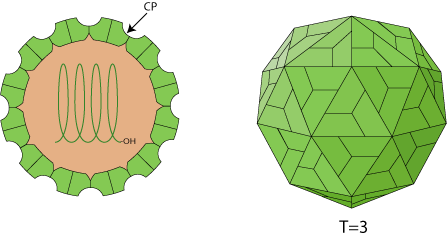Enamovirus (taxid:12289)
VIRION

Non-enveloped, spherical virion about 25 nm in diameter with T=3 icosahedral symmetry composed of 180 CP proteins
GENOME
Monopartite, linear, ssRNA(+) genome of 5.7 kb with a VPg bound at the 5' end. There is no poly(A) tail or tRNA-like structure at the 3' end. Since PEMV-1 genome does not encode any movement protein, the virus requires thenhost cell to be co-infected with an umbravirus for systemic movement.
GENE EXPRESSION
The virion RNA is infectious and serves as both the genome and viral messenger RNA. The P1 protein is produced by leaky scanning of the genomic RNA. The viral polymerase is expressed by a ribosomal frameshifting at the end of ORF1. Suppression of termination of the CP stop codon produces CP-RTD (CP extended), the capsid subunit essential for aphid transmission.
ENZYMES
- RNA-directed RNA polymerase [RdRp]
- VPG-type capping [VPg]
- Polyprotein major protease (Peptidase S39) [Pro]
REPLICATION
CYTOPLASMIC
- Virus penetrates into the host cell.
- Uncoating, and release of the viral genomic RNA into the cytoplasm.
- The viral RNA ORF1 and ORF2 are translated to produce the RdRp fusion protein.
- Replication takes place in cytoplasmic viral factories. A dsRNA genome is synthesized from the genomic ssRNA(+).
- The dsRNA genome is transcribed/replicated thereby providing viral mRNAs/new ssRNA(+) genomes.
- Expression of the 3' coterminal sgRNAs. Traduction of these sgRNAs yields the capsid and CP-RTD.
- Virus assembly.
- Viral movement proteins provided by an umbravirus probably mediate virion cell-to-cell transfer.
Host-virus interaction
Suppression of RNA silencing
Enamovirus P0 protein acts as a suppressor of RNA silencing by targeting Argonaute 1 for degradation

Matching UniProtKB/Swiss-Prot entries
(all links/actions below point to uniprot.org website)5 entries grouped by strain
5 entries
